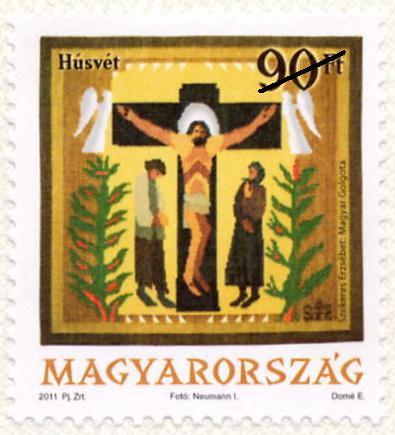
1. MAGYAR - HÚSVÉT 2011 - Bélyeg rendelési kód: 2011 év bélyegei kompletten
2. ENGLISH - EASTER 2011 - Order code of the stamp: 2011 Year stamps complete
3. GERMAN - OSTERN 2011 - Die Bestellnummer Der Marke: 2011 Jahr Briefmarken komplett
Michel:
1. MAGYAR - HÚSVÉT 2011
A húsvéti jókívánságok postára adásához hagyományai szerint ez évben is új forgalmi bélyeget bocsát ki a Magyar Posta. A bélyegképen Szekeres Erzsébet „Magyar Golgota” elnevezésű textilképének reprodukciója látható. A bélyeghez tartozó alkalmi borítékot Szekeres Erzsébet Az Isten báránya c. alkotásának részlete díszíti. Az alkalmi bélyegző grafikáján a borítékon szereplő bárány stilizált rajza található.
„A golgota héber eredetű szó. Maga a szó alakja: „gulgólet”, melynek az arámi átírása („gulultá”) honosodott meg a mai szóhasználatban. A görögben „kranion”, a latinban pedig „calvaria” alakban maradt meg, ebből származik a kálvária szavunk. A szó jelentése: koponya/koponyahely. Eredetileg egy Jeruzsálemtől északra, északnyugatra fekvő kőbányához kapcsolódó magaslat volt, amely az ókori időkben a kivégzések helyéül szolgált. Nevét valószínűleg a kivégzésekből hátramaradt csontok után kaphatta.
Az evangéliumok tanúsága szerint itt feszítették keresztre Jézust, és itt is temették el.
A hely azonosítása kérdéses, de a legvalószínűbb az, hogy a nyugati és az északi városfal találkozásánál lévő „derékszögnél” lehetett. János adata is fontos, miszerint a kivégzőhely nem volt messze a várostól, mivel a Jézus keresztjén lévő feliratot sokan olvasták a zsidók közül (Jn. 19, 19-20). Lehetséges, hogy a Jaffát Aszkalonnal összekötő kereskedelmi út mellett feküdt.
Hadrianus császár i. sz. 135-ben Iuppiter tiszteletére építtetett bazilikát ezen a helyen, majd az i. sz. IV. század táján Szent Ilona császárné építtette fel a mai Szentsír-bazilikát azon a helyen. Ma Jeruzsálem óvárosának keresztény negyedében található meg.” (Forrás: hu.wikipedia.org)
Forrás: Posta
2. ENGLISH - EASTER 2011
In keeping with its traditions Magyar Posta is releasing a new postage stamp to send greetings at Easter. The stamp design uses a reproduction of a work by the textile artist Erzsébet Szekeres entitled Hungarian Golgotha. The stamp’s first day cover is adorned by a detail from another work by the same artist, Lamb of God. The graphic design of the special postmark employs a stylised version of the lamb on the cover.
The word golgotha is derived from the Hebrew gulgoleth, and the Aramaic transcription of this (gulgalta) has been adopted and adapted in modern use. In Greek this is kranion, while the Latin translation calvaria provides the derivation of our word calvary. The word means skull or place of skulls. Originally, it was the name of a hill in a quarry north north-west of Jerusalem, which was a place of execution in ancient times. The name probably refers to the skulls remaining from the executions. According to the Gospels this is the place where Jesus was crucified and buried.
The precise spot is questionable but it is probably at the right angle where the western and northern city walls meet. The description given in St John’s gospel is also important as it says that the place of execution was near the city as the sign fastened to Jesus’ cross was read by many Jews (John 19, 19-20). It is possible that it was next to the trade route connecting Jaffa and Ashkelon.
In AD 135 Hadrian built a temple dedicated to Jupiter over the site, and then in the 4th century St Helena, mother of the Emperor Constantine, constructed the present Church of the Holy Sepulchre there. Today it is surrounded by the Christian quarter of the Old City of Jerusalem. (Source: hu.wikipedia.org)
3. GERMAN - OSTERN 2011
Traditionsgemäß gibt die Magyar Posta auch dieses Jahr eine neue Freimarke für die Aufgabe von Glückwünschen zu Ostern aus. Auf dem Briefmarkenbild ist die Reproduktion des Textilbildes „Ungarisches Golgota” von Erzsébet Szekeres zu sehen. Den zur Briefmarke gehörenden Sonderumschlag ziert ein Ausschnitt des Werkes „Das Lamm Gottes” von Erzsébet Szekeres. Auf der Grafik des Sonderstempels ist die stilisierte Zeichnung des auf dem Umschlag abgebildeten Lammes auffindbar.
„Golgota (auch Golgatha) ist ein Wort hebräischen Ursprungs. Die Wortform selbst ist „gulgólet”, deren aramäische Transkription („gulultá”) in den heutigen Wortgebrauch übernommen worden ist. Im Griechischen blieb die Form „kranion”, im Lateinischen die Form „calvaria” erhalten, daraus stammt unser Wort „kálvária” (dt. Kalvarienberg). Die Wortbedeutung ist Schädel/Schädelstätte. Ursprünglich handelte es sich um einen nördlich, nord-westlich von Jerusalem gelegenen, mit einem Steinbruch verbundenen Hügel, der in der Antike als Hinrichtungsstätte diente. Seinen Namen bekam er wahrscheinlich aufgrund der Knochen, die von den Hinrichtungen zurückgeblieben waren. Nach dem Zeugnis der Evangelien wurde Jesus hier gekreuzigt und auch bestattet.
Die Lokalisierung der Stätte ist fragwürdig, aber am wahrscheinlichsten ist es, dass sie sich im „rechten Winkel”, in der Nordwestecke der damaligen Stadtmauer befand. Auch der Bericht von Johannes ist wichtig: „Dieses Schild lasen viele Juden, weil der Platz, wo Jesus gekreuzigt wurde, nahe bei der Stadt lag.” (Joh 19, 19-20). Möglicherweise lag er an dem Handelsweg, der Jaffa mit Askalon verbindet.
Kaiser Hadrian 135 u. Z. ließ zu Ehren von luppiter an diesem Ort einen Tempel errichten. Später, um das 4. Jahrhundert u. Z., ließ Kaiserin Sankt Helena eine Basilika, die so genannte Grabeskirche, die jetzige Heilige Grabeskirche erbauen. Heute ist sie im christlichen Viertel der Altstadt von Jerusalem aufzufinden. (Quelle: hu.wikipedia.org)










